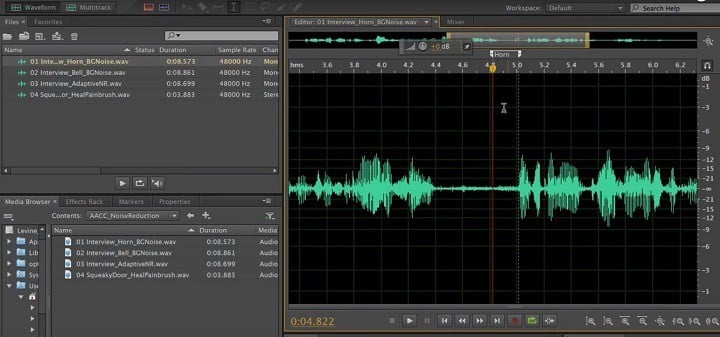

RAM is hundreds – if not thousands – of times faster than even an SSD. We don’t want your CPU having to use your SSD or (perish the thought) your spinning hard drive to have to store memory. If you’re running Premiere at the same time you’ll want to make sure you have plenty of RAM available for all. Go to Preferences/Memory and insure that you have the maximum amount of memory possible allocated to Adobe products – especially Audition.

Run the buffer setting down to 128 or less for recording.Ģ. Generally a setting of 512 is enough for most applications for playback only sessions. Audition easily adjusts the timing of all tracks and video to remain in sync. Latency really doesn’t matter in playback-only environments. But don’t expect to record ADR or vocals. The LARGER the buffer size, the BIGGER the chunks the computer can handle at a time, the easier it is to have more tracks running and generally the snappier playback performance is in large track environments. The problem is the smaller the buffer the harder it is on the CPU. If this latency is too long, it because really difficult for the performer to stay in sync. This is super important when doing ADR or musical vocal recordings, because the smaller the buffer size the less latency there is between when Audition receives incoming audio, processes it, and sends it back out to the listeners (performers etc.). The smaller these chunks are – or “buffers” the faster Audition can process data.

If you go Preferences/Audio Hardware/I/O Buffer Size you’ll be able to control the “chunks” that Audition uses to process audio data. One of the easiest ways to speed up Audition is to SLOW things down.
Adobe audition audio recording how to#
In this article, we’ll show you how to speed up Adobe Audition with these tips which come straight from the mouths of the Audition development team! Speed Up Audition now! We want to be able to have our DAW be able to efficiently access all the horsepower of our computer so that we can focus on mixing and processing quality audio – instead of dealing with computer issues. Add to this, video, hundreds of tracks, complex bussing and surround outputs, and a CPU really has to chunk the data fast. Add a bunch of plugins and busses, and even the most simple of track counts can bog down fast CPUs. Speeding up your DAW is always a good idea even if you aren’t using a plethora of tracks.


 0 kommentar(er)
0 kommentar(er)
